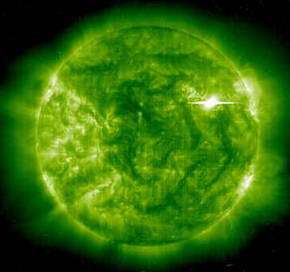Jupiter: A cloudy mirror for the Sun?

Astronomers using the European Space Agency's XMM-Newton telescope have discovered that observing the giant planet Jupiter may actually give them an insight in to solar activity on the far side of the Sun! In research reported in the most recent edition of Geophysical Research Letters, they discovered that Jupiter's x-ray glow is due to x-rays from the Sun being reflected back off the planet's atmosphere.
Image: The solar flare of 2 April 2001 observed by the EIT on SOHO (Credit ESA)
Jupiter is an intriguing object when viewed in x-rays; it has dramatic x-ray auroras at the poles and a variable x-ray glow from near the equator. Researchers had theorised that these x-rays from the equatorial regions of Jupiter, called disk x-rays, were controlled by the Sun. In November 2003, during a period of high solar activity, they observed Jupiter.
"We found that Jupiter's day-to-day disk x-rays were synchronised with the Sun's emissions," says Dr Anil Bhardwaj, from NASA Marshall Space Flight Centre and lead author on the paper. "Unfortunately, we missed a relatively large solar flare during the 3.5-days observation due to the perigee passage of the XMM-Newton". "But, still we were lucky; particularly clear was a signature of a moderate solar flare that went off during the observing period - there was a corresponding brightening of the Jovian disk x-rays", says Anil Bhardwaj.
In addition to supporting the researchers' theory, this result has another application - in studying the Sun. The Sun is a very dynamic environment and processes there have an impact on human activities. For example, solar flares (the most powerful explosions in the solar system) can damage satellites or injure astronauts in space, and on Earth they can disrupt radio signals in the atmosphere, so it is important to understand as much as we can about them.
There are several dedicated spacecraft watching the Sun (such as the European Space Agency's SOHO satellite), as well as ground-based telescopes, but there are gaps in coverage as some areas of the Sun are not visible by any of these means at some times.
"As Jupiter orbits the Sun, we hope to be able to learn more about the active areas of the Sun we can't see from Earth by watching the Jovian x-ray emissions," says Dr Graziella Branduardi-Raymont from the University College London's Mullard Space Science Laboratory. "If a large solar flare occurs on an area of the Sun that is facing Jupiter, we may be able to observe it in light scattered from Jupiter, even if we cannot see that region of the Sun from around the Earth at the time."
Jupiter's atmosphere is not a perfect mirror of the Sunlight in X-rays - typically one in a few thousand x-ray photons (packets of light) is reflected back, but the more energetic the photons, the more are reflected into space.
UK participation in this research and the UK subscription to the European Space Agency are funded by the Particle Physics and Astronomy Research Council (PPARC).
The paper 'Solar Control on Jupiter's equatorial X-ray emissions: 26-29 November 2003 XMM-Newton observation' was selected as an AGU Journal Highlight of Geophysical Research Letters, VOL. 32, NO. 3, 2005
What are solar flares?
A solar flare is a tremendous explosion on the Sun that happens when energy stored in 'twisted' magnetic fields (usually above sunspots) is suddenly released.
In a matter of just a few minutes they heat material to many millions of degrees and produce a burst of radiation across the electromagnetic spectrum, including from radio waves to x-rays and gamma rays.
Source: PPARC















